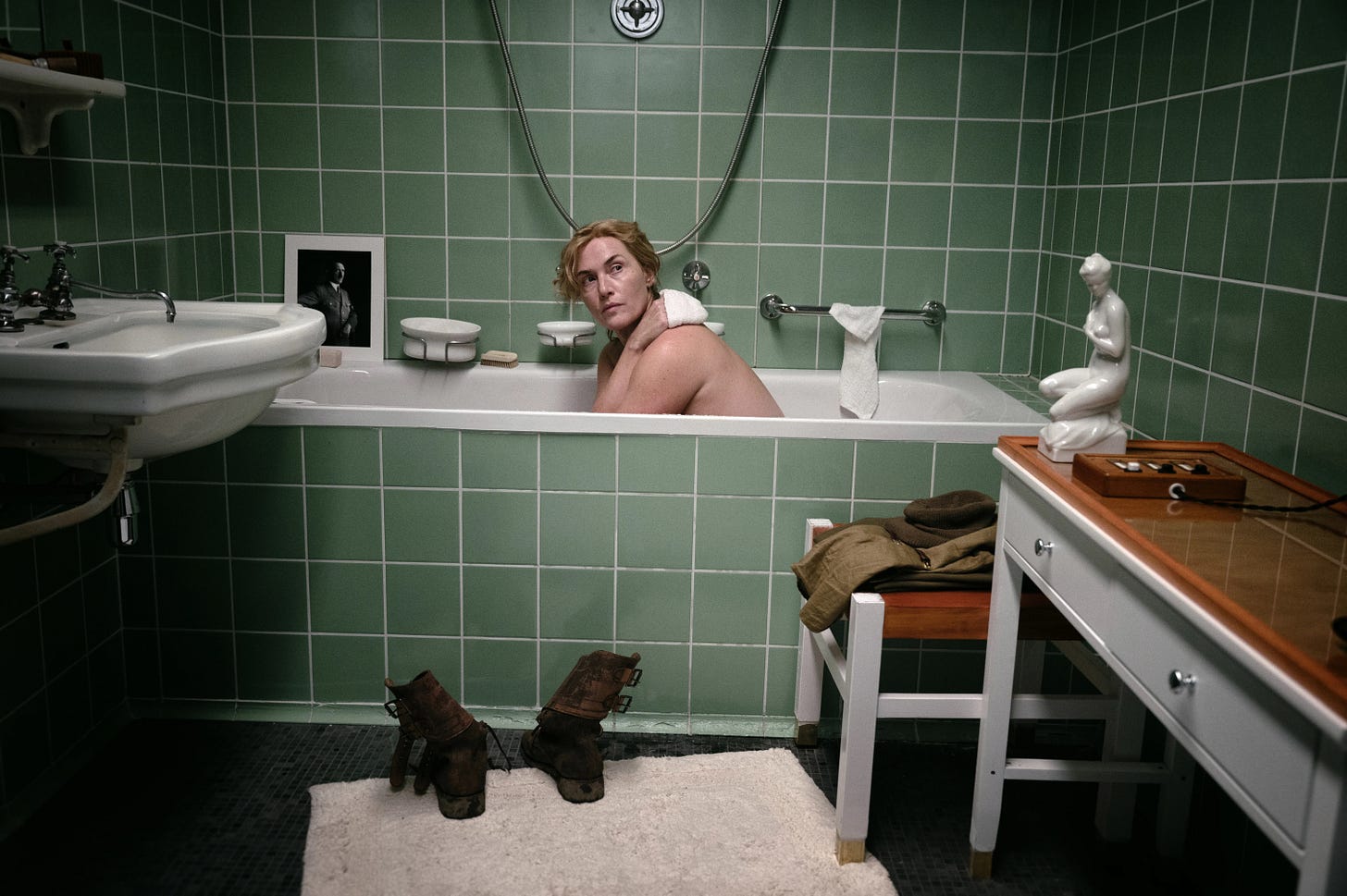‘Lee’ Review: What a Picture Is Worth
Biopic about war photographer Lee Miller occasionally succeeds in evoking her singular vision.

LEE OPENS WITH ITS HEROINE, war correspondent Lee Miller, under fire in Nazi-occupied France. In a bulky, dusty uniform, clutching her camera and firing it whenever she can, she scuttles behind a barrier. The earth beside her explodes, and as she recovers from the attack, we see her hand raised in the smoke. Strange, out of place, a stark vertical amid drifts and swirls.
This is a moment when the film honors Lee Miller not only for her bravery—she became one of the first Americans to see and document the death camps—but for her vision. Miller’s photographs from World War II are unforgettable not because of what she saw but how she saw it: as a Surrealist, an artist of the unsettling and the absurd, an ironist and a chronicler of a jarring, off-kilter, incomprehensible world where a cluster of snail shells can evoke terror and a demolished building can prompt laughter.
Lee only rarely captures Miller’s artistic vision. As directed by Ellen Kuras, Kate Winslet’s Lee is angry and damaged. She’s brave in a comprehensible, irritable way, complaining about men who are “so patronizing!” As a study of character, the film is mediocre. Its dialogue is often lugubrious and trite: Lee photographs the teenage daughter of a Nazi family who all died by suicide and muses, “There’s so much life in a person’s eyes. Right until there isn’t.” The music, by Alexandre Desplat, works well when it’s eerie, but when the film is feeling sorry for poor Lee, we get tinkly, sentimental piano, the curse of contemporary film.
Too much is stated, as if the script is afraid we are checking our phones. And it’s not because Kuras is incapable of conveying meaning through action, expression, and visual language. There are two searing scenes in which Lee’s reactions make it clear that she was raped as a child. These scenes have a ferocious power, because they show the effect of this violation on Lee as an adult—the anguish, empathy, and fury; the strength she must find to defend others. A later scene in which she states her trauma, by contrast, feels didactic, adding nothing to what the previous scenes have already shown us except words.
Lee is humorless, whereas Lee Miller’s work was filled with both playful and gallows humor: While Lee is in London during the Blitz, we see a church doorway blocked by the bricks that bombs have shaken from the walls. The film treats this simply as an image of damage, whereas the real-life Miller gave this photo the cheeky title, “Non-conformist Chapel.” She titled a smashed typewriter “Remington Silent,” a statue toppled beneath an iron bar “Revenge on Culture”; she shot a straightforward image of the Blitz spirit, a newspaper promotional board inscribed with the headline, “LONDONS NO NIGHT RAID/ONE NIGHT OF LOVE.” She enjoyed incongruities—geese wandering between elegant loops of barbed wire and a barrage balloon; the intersecting sharp and ragged shapes of a torn tent looking out on the desert. Lee misses this aspect of Miller’s impact. She was an extraordinary war correspondent because even before the war, she had learned to depict a world where any moment might bring derangement. In Lee, she’s an extraordinary war correspondent mostly because she was there.
And yet as I return to the film in memory, it grows—mainly because of the moments where Kuras finds a way of speaking that can only be done with film. One of Miller’s most famous gallows-humor moments found her bathing in Hitler’s tub, at the dead dictator’s Munich apartment in July 1945. This picture, by David Scherman, was published with Miller’s work under the title, “Hitleriana,” in a photoessay by Miller that emphasized the Nazis’ penchant for tackiness and kitsch. It’s a victors’ photo. Kuras’s staging of that scene, by contrast, is laden with horror. Lee and David (Andy Samberg) move through the crowds of shocky, partying soldiers, in a house where every artifact and painting makes Hitler more present than if he were standing right beside them. Hitler is palpable in that scene, and that feeling, that the enemy is not defeated but somehow permeating and pervasive, is one of the most powerful visual representations of PTSD that I’ve seen.

When Lee and David reach the death camps, the film captures the contrast between the Germans’ willful ignorance and the horror they refused to witness: Women chat and children play as Lee and David cough and choke in the stench from cattle cars full of bodies. Lee conveys deep terror and even shame as it shows the Americans encountering and photographing stacked corpses. We cut between past and present, allowing the camera to linger on the real photos rather than on its own staging of the bodies. Winslet moves haltingly, her fingers bumping uselessly against her chair, as if she’s been physically injured by what Lee witnessed. Miller’s reportage from Germany was furious, determined to prove to the world that the Holocaust happened and that the Germans knew. In these scenes, Kuras’s film meets Miller’s purpose.
Biopics often succumb to the temptation to focus on feelings and reasons, when feelings and reasons are usually not why we care about the film’s subject; we care about their work, but they’ve already done that part, so feelings and reasons are what’s left over for the filmmakers to gnaw. There are images and scenes in which Lee crafts its own powerful artistic vocabulary. But in the end, as with so many well-intentioned biopics, the best thing about this movie is the attention it will draw to its brilliant, visionary subject.



